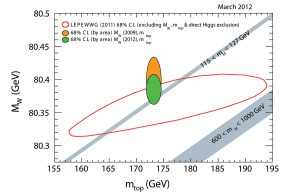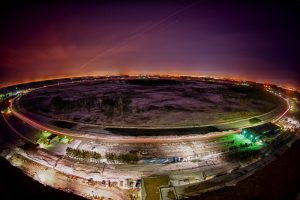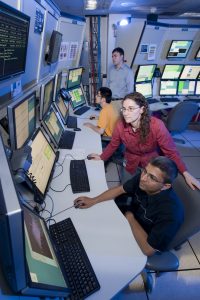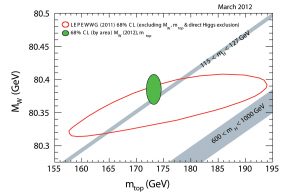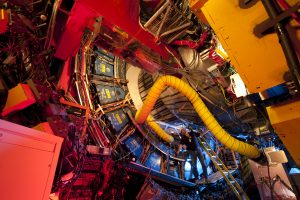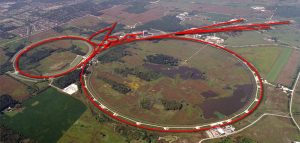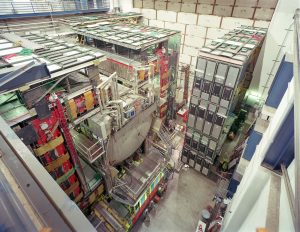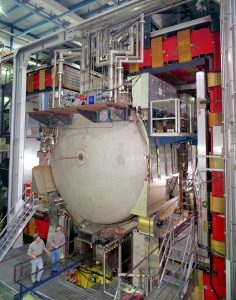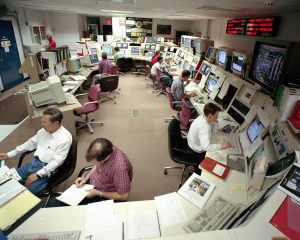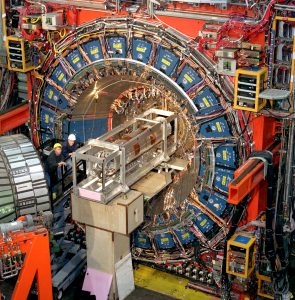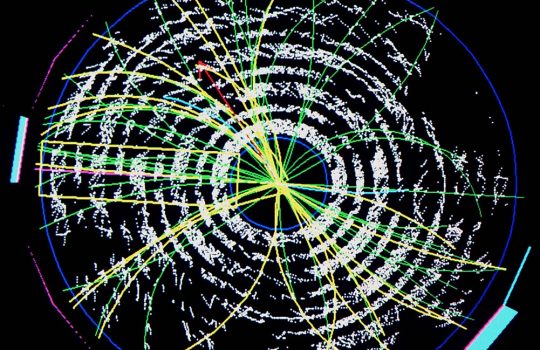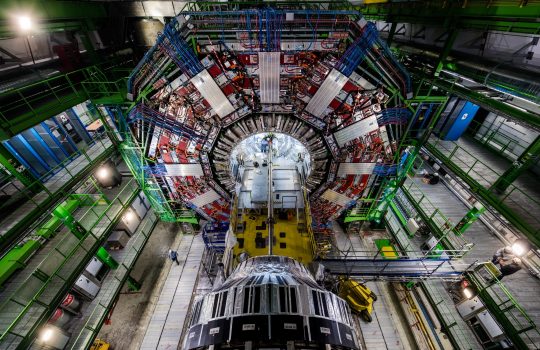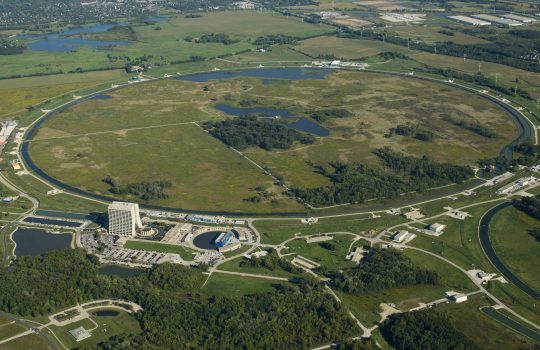The world’s most precise measurement of the mass of the W boson, one of nature’s elementary particles, has been achieved by scientists from the CDF and DZero collaborations at the Department of Energy’s Fermi National Accelerator Laboratory. The new measurement is an important, independent constraint of the mass of the theorized Higgs boson. It also provides a rigorous test of the Standard Model that serves as the blueprint for our world, detailing the properties of the building blocks of matter and how they interact.
The Higgs boson is the last undiscovered component of the Standard Model and theorized to give all other particles their masses. Scientists employ two techniques to find the hiding place of the Higgs particle: the direct production of Higgs particles and precision measurements of other particles and forces that could be influenced by the existence of a Higgs particles. The new measurement of the W boson mass falls into the precision category.
The CDF collaboration measured the W boson mass to be 80387 ± 19 MeV/c2. The DZero collaboration measured the particle’s mass to be 80375 ± 23 MeV/c2. The two measurements combined along with the addition of previous data from the earliest operation of the Tevatron produces a measurement of 80387 ± 17 MeV/c2, which has a precision of 0.02 percent.
These ultra-precise, rigorous measurements took up to five years for the collaborations to complete independently. The collaborations measured the particle’s mass in six different ways, which all match and combine for a result that is twice as precise as the previous measurement. The results were presented at seminars at Fermilab over the past two weeks by physicists Ashutosh Kotwal from Duke University and Jan Stark from the Laboratoire de Physique Subatomique et de Cosmologie in Grenoble, France.
“This measurement illustrates the great contributions that the Tevatron has made and continues to make with further analysis of its accumulated data,” said Fermilab Director Pier Oddone. “The precision of the measurement is unprecedented and allows rigorous tests of our underlying theory of how the universe works.”
The new W mass measurement and the latest precision determination of the mass of the top quark from Fermilab triangulate the location of the Higgs particle and restrict its mass to less than 152 GeV/c2 .This is in agreement with the latest direct searches at the LHC, which constrain the Higgs mass to less than 127 GeV/c2, and direct-search limits from the Tevatron, which point to a Higgs mass of less than 156 GeV/c2, before the update of their results expected for next week.
“The Tevatron has expanded the way we view particle physics,” said CDF co-spokesperson and Fermilab physicist Rob Roser. “Tevatron experiments discovered the top quark, made precision measurements of the W boson mass, observed B_s mixing and set many limits on potential new physics theories.”
The new measurement comes at a pivotal time, just days before physicists from the Tevatron and the Large Hadron Collider at CERN will present their latest direct-search results in the hunt for the Higgs at the annual conference on Electroweak Interactions and Unified Theories known as Rencontres de Moriond in Italy. The CDF and DZero experiments plan to present their latest results on Wednesday, March 7.
“It is a very exciting time to analyze data at particle colliders,” said Gregorio Bernardi, DZero co-spokesperson and physicist at the Laboratoire de Physique Nucléaire et de Hautes Energies in Paris. “The next few months will confirm if the Standard Model is correct, or if there are other particles and forces yet to be discovered.”
The existence of the world we live in depends on the W boson mass being heavy rather than massless as the Standard Model predicts. The W boson is a carrier of the electroweak nuclear force that is responsible for such fundamental process as the production of energy in the sun.
“The W mass is a very distinctive feature of the universe we live in, and requires an explanation,” said Giovanni Punzi, CDF co-spokesperson and physicist from the University of Pisa. “Its precise value is perhaps the most striking evidence for something “out there” still to be found, be it the Higgs or some variation of it.”
“The measurement of the W boson mass will be one of the great scientific legacies of the Tevatron particle collider,” added DZero co-spokesperson and Fermilab scientist Dmitri Denisov.
Notes for Editors:
Funding for the CDF and DZero experiments comes from DOE’s Office of Science, the U.S. National Science Foundation, and numerous international funding agencies.
CDF collaborating institutions are at http://www-cdf.fnal.gov/collaboration/index.html
DZero collaborating institutions are at http://www-d0.fnal.gov/ib/Institutions.html
Fermilab, America’s only national laboratory fully dedicated to particle physics research, is a U.S. Department of Energy Office of Science laboratory operated under contract by the Fermi Research Alliance, LLC. Visit Fermilab’s website at http://www.fnal.gov.
The DOE Office of Science is the single largest supporter of basic research in the physical sciences in the United States, and is working to address some of the most pressing challenges of our time. For more information, please visit http://science.energy.gov.
- The orange oval shows the previous CDF and DZero combined result for the W boson mass (vertical section of the oval), combined with the world’s best value for the top quark mass (horizontal section of the oval). The green oval shows the new result. The grey bar shows the remaining areas not ruled out for where the Higgs boson could reside.
- The Tevatron typically produces about 10 million proton-antiproton collisions per second. Each collision produces hundreds of particles. About 200 collisions per second are recorded at each detector for further analysis.
- Control room for CDF where particle sprays from collisions are analyzed.
- The new CDF and Dzero combined result for the W boson mass (vertical section of green oval), combined with the world’s best value for the top quark mass (horizontal section of green oval), restricts the Higgs mass requiring it to be less than 152 GeV/c2 with 95 percent probability. Direct searches have narrowed the allowed Higgs mass range to 115-127 GeV/c2. The grey bar shows the remaining area the Higgs could reside in.
- The three-story, 6,000-ton CDF detector takes snapshots of the particles that emerge when protons and antiprotons collide.
- The 4-mile in circumference Tevatron accelerator at Fermilab uses superconducting magnets chilled to minus 450 degrees Fahrenheit, as cold as outer space, to move particles at nearly the speed of light.
- Scientists measure the energy, momentum and electric charges of subatomic particles using a three-story assembly of sub detectors wrapped around DZero’s collision area like the layers of an onion.
- Scientists measure the energy, momentum and electric charges of subatomic particles using a three-story assembly of sub detectors wrapped around DZero’s collision area like the layers of an onion.
- Control room for CDF where particle sprays from collisions are analyzed.
- The three-story, 6,000-ton CDF detector takes snapshots of the particles that emerge when protons and antiprotons collide.

